Abstract
Fluorescence techniques have been employed to study the interaction of porcine and equine colipase with pure taurodeoxycholate and mixed micelles. Nitrotyrosine-55 of porcine colipase is obtained by modification with tetranitromethane (low excess, in the presence of taurodeoxycholate) of the protein followed by gel filtration and ion-exchange chromatography. Verification of the residue modified was obtained by h.p.l.c. peptide purification and sequence analysis. Reduction and quantitative reaction with dansyl chloride yields a fluorescent derivative that is twice as active in conjunction with lipase as is native colipase and that exhibits a strong emission band at 550 nm. Addition of micellar concentrations of taurodeoxycholate causes a 4.3-fold increase in the emission maximum as well as a 70 nm blue shift to 480 nm. Inclusion of oleic acid to form a mixed micelle reduces these spectral effects. Scatchard analysis of the data yield a Kd of 6.8 X 10(-4) M and a single colipase-binding site for taurodeoxycholate micelles. The data, by analogy to a phospholipase system, are consistent with a direct insertion of dansyl-NH-tyrosine-55 into the micelle. The presence of a single tryptophan residue (Trp-52) in equine colipase provides an intrinsic fluorescent probe for studying protein-micelle interaction. The emission maximum of horse colipase at 345 nm indicates a solvent-accessible tryptophan residue which becomes less so on binding of micelles. A blue shift of 8 nm and a 2-fold increase in amplitude is indicative of a more hydrophobic environment for tryptophan induced by taurodeoxycholate micelles. There is also a decrease in KSV for acrylamide quenching in the presence of micelles, which further supports a loss of solvent accessibility. The most dramatic pH effects are observed with KI quenching, and may indicate the presence of negative charges near Trp-52.
Full text
PDF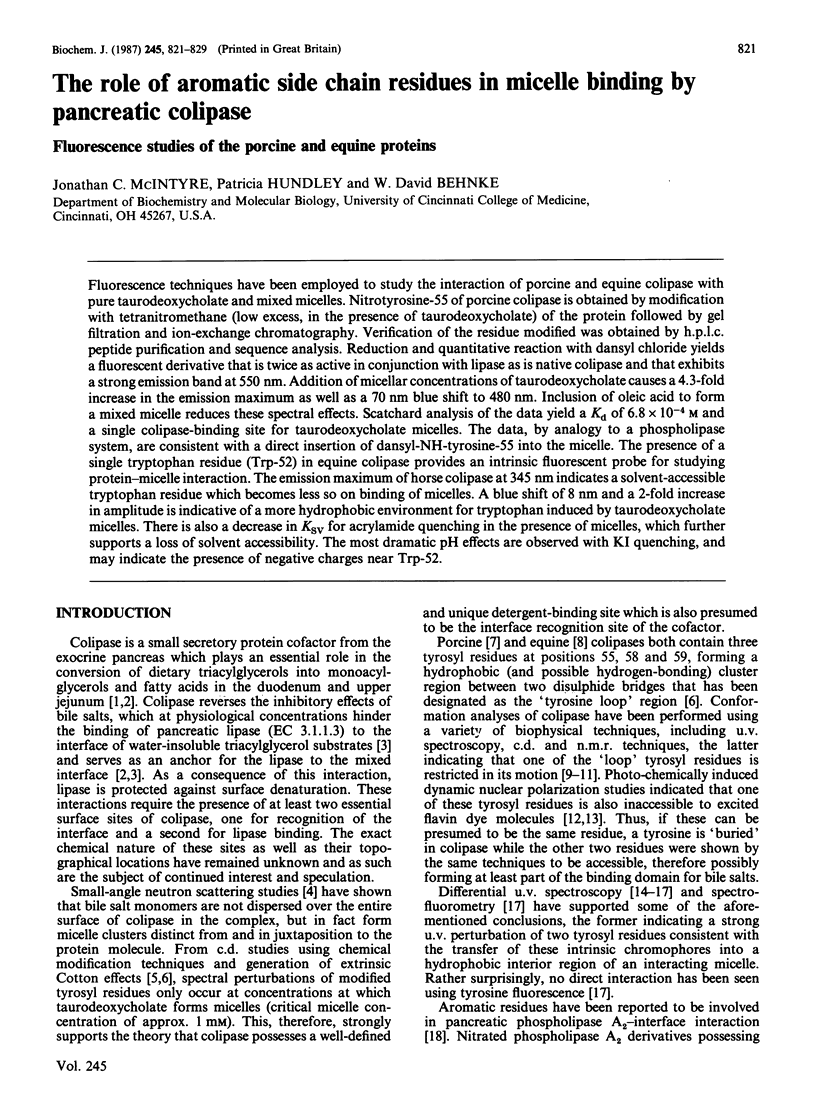
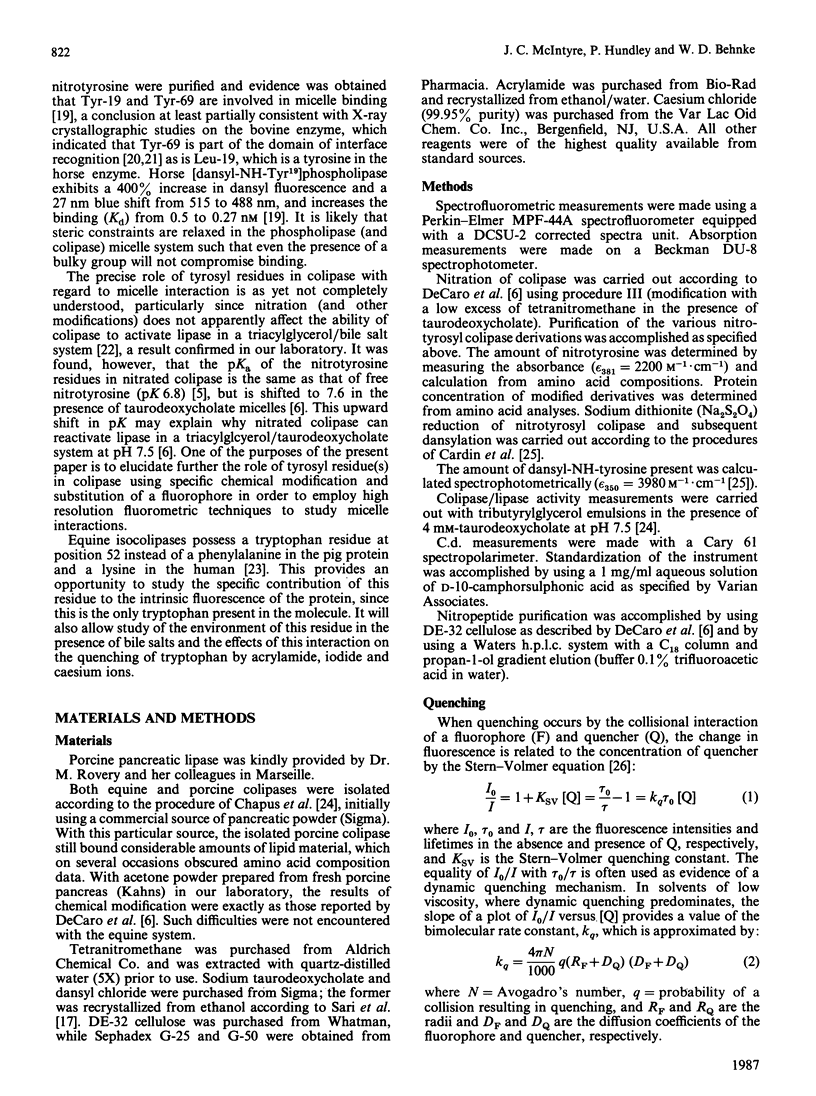
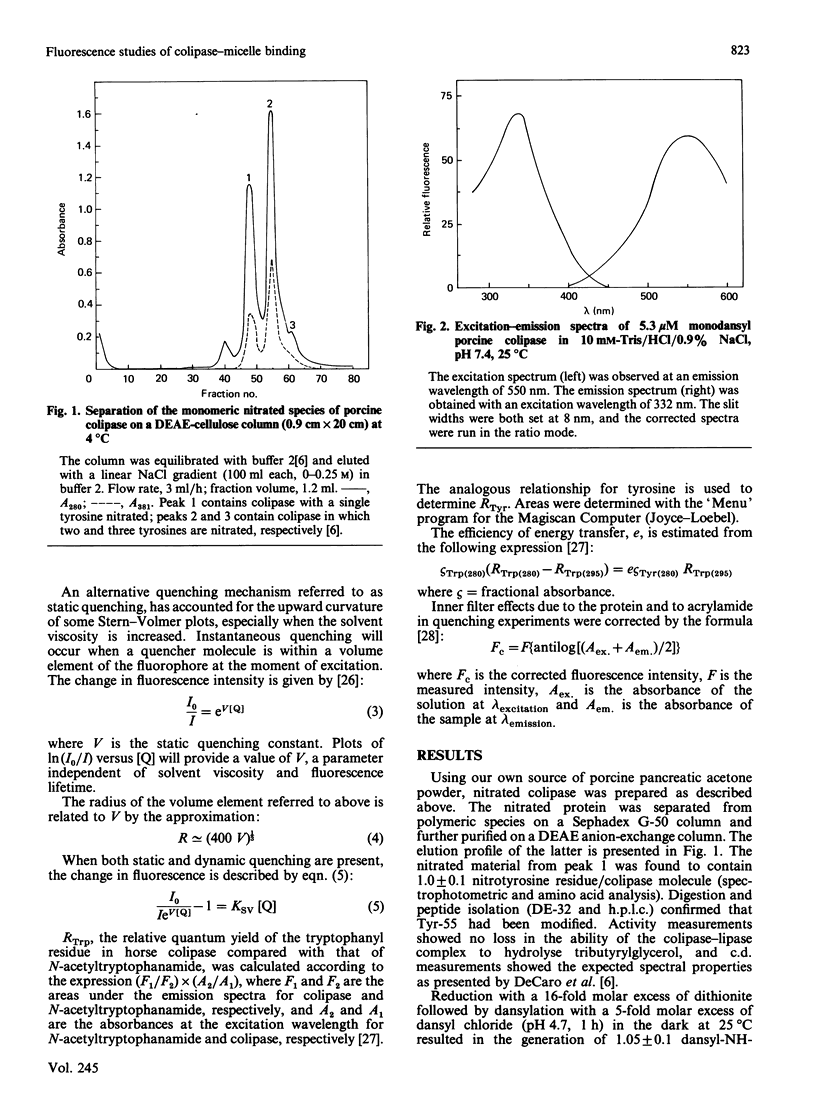
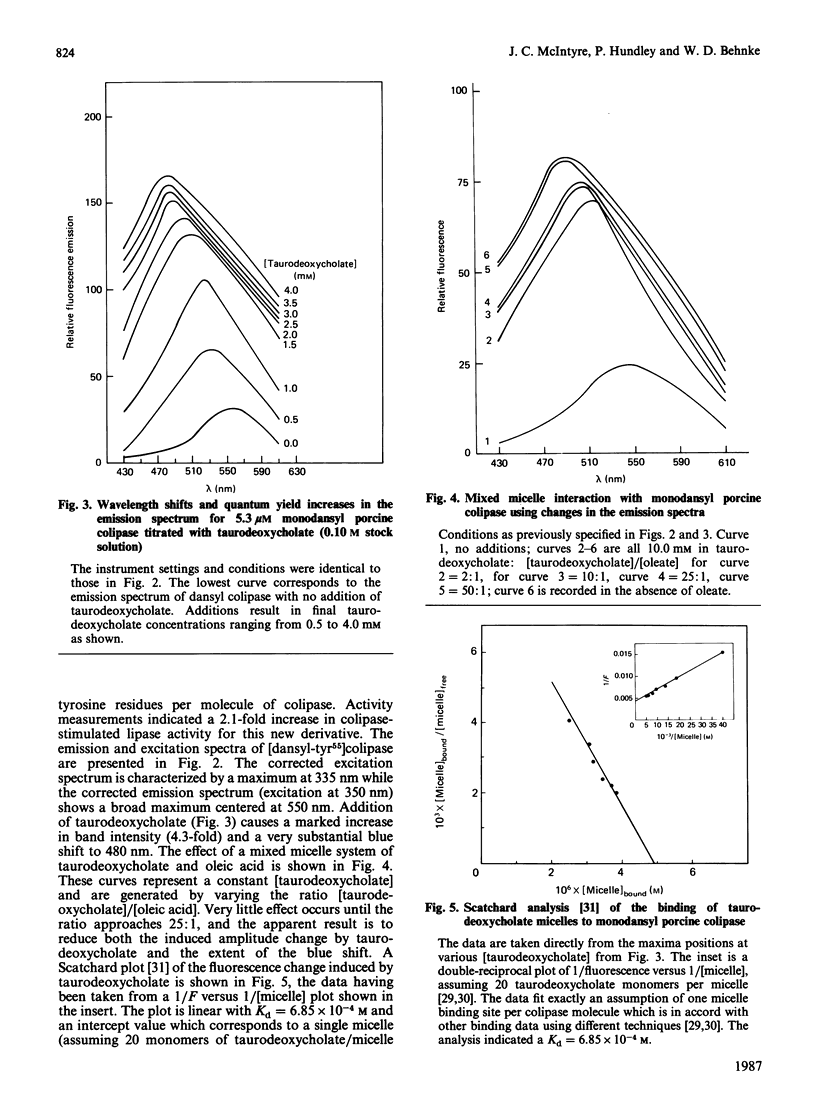
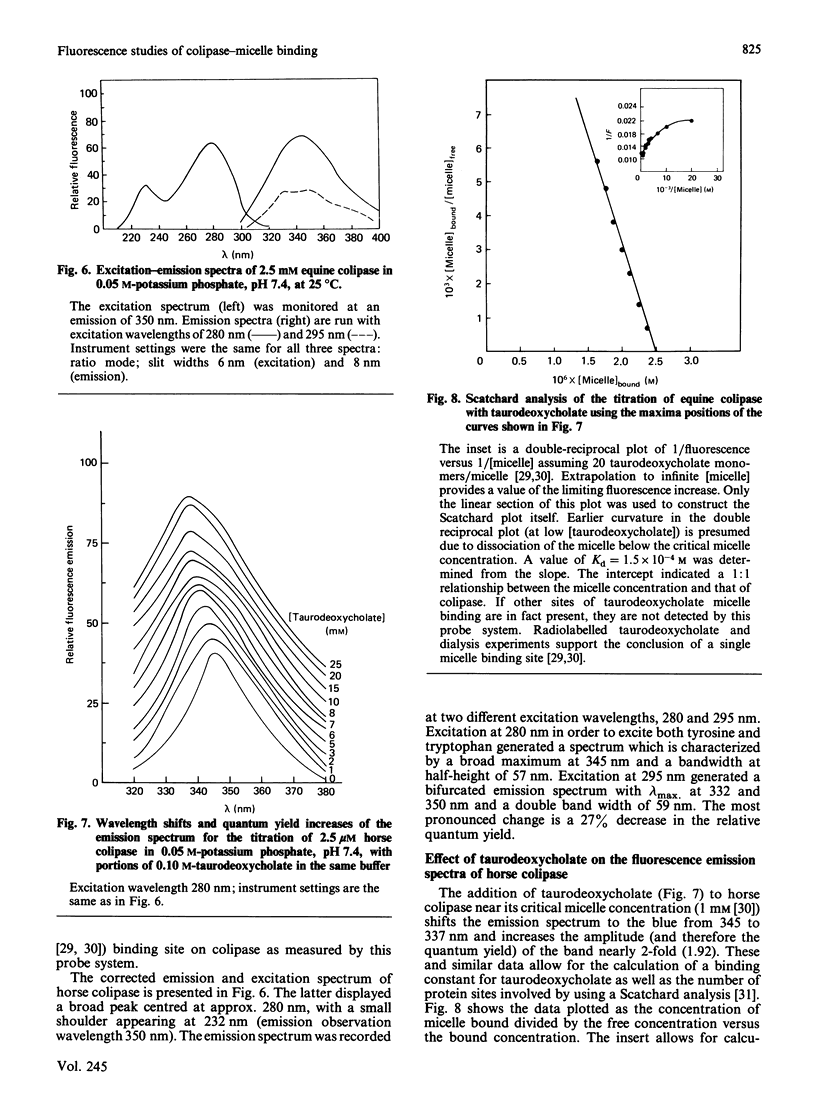
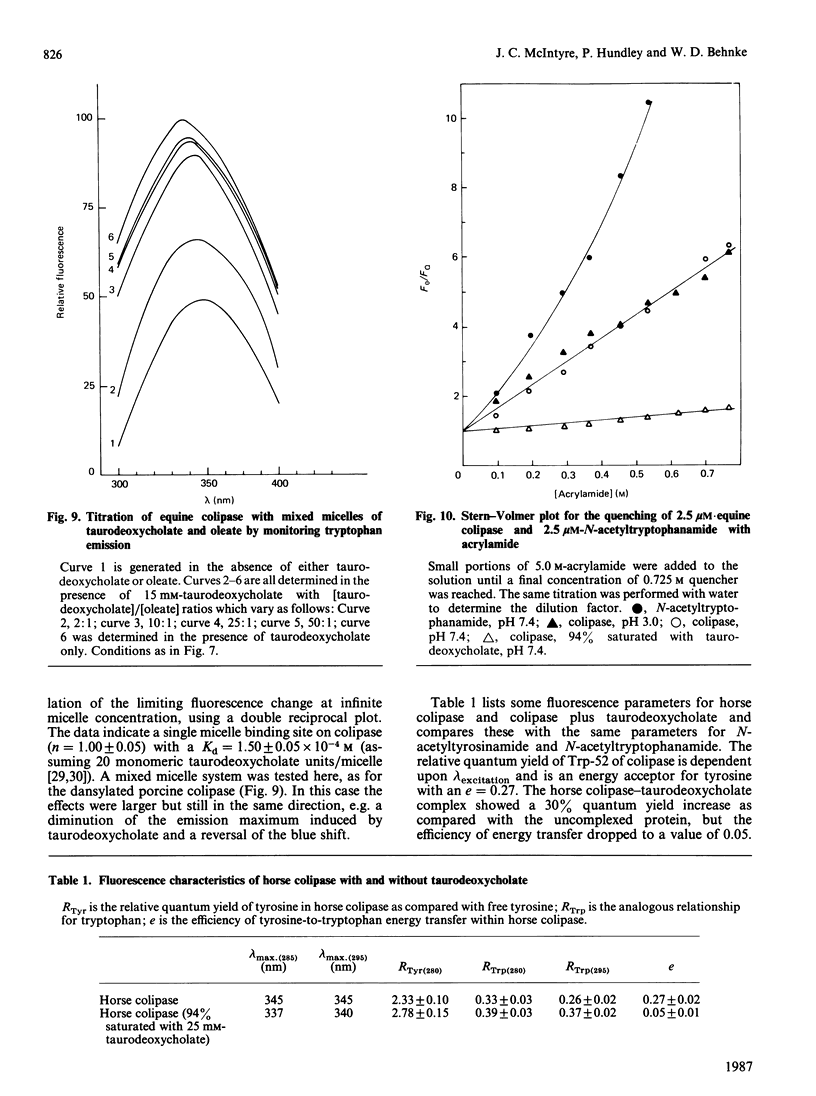
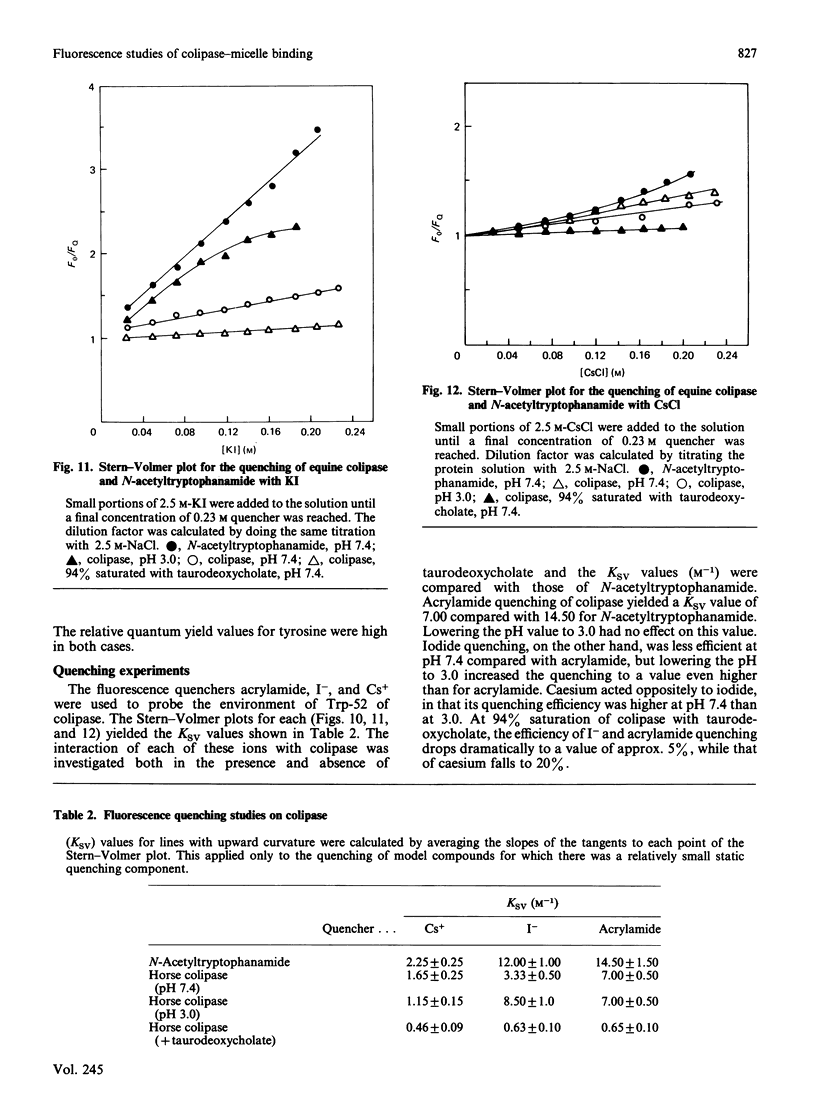
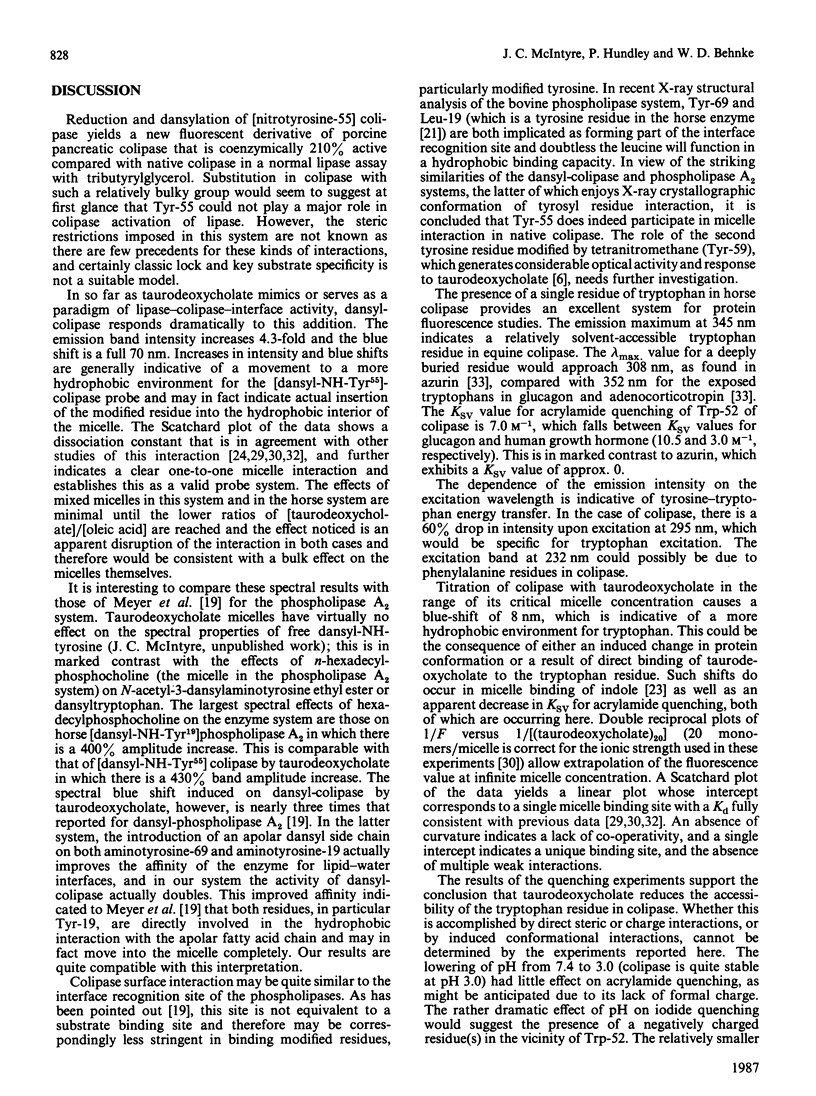
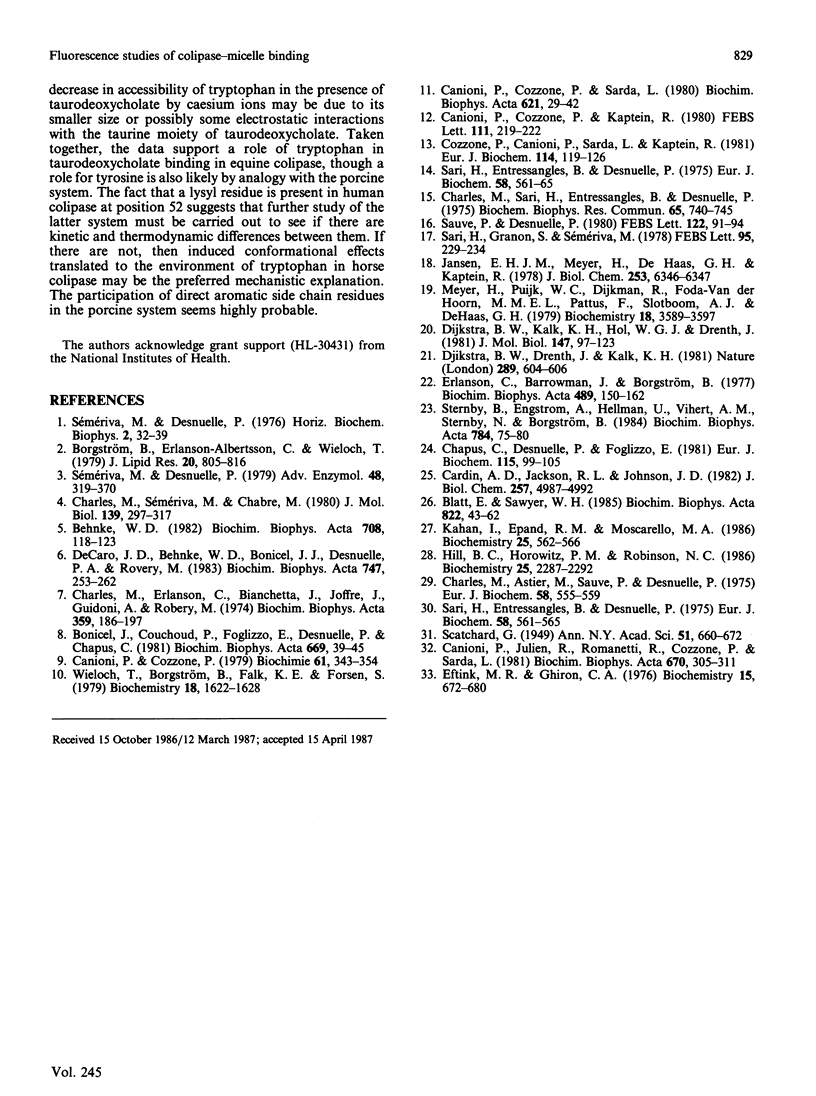
Selected References
These references are in PubMed. This may not be the complete list of references from this article.
- Behnke W. D. The reaction of porcine colipase a with tetranitromethane. Generation of extrinsic cotton effects in the visible region. Biochim Biophys Acta. 1982 Nov 9;708(2):118–123. doi: 10.1016/0167-4838(82)90211-4. [DOI] [PubMed] [Google Scholar]
- Blatt E., Sawyer W. H. Depth-dependent fluorescent quenching in micelles and membranes. Biochim Biophys Acta. 1985 Jun 12;822(1):43–62. doi: 10.1016/0304-4157(85)90003-6. [DOI] [PubMed] [Google Scholar]
- Bonicel J., Couchoud P., Foglizzo E., Desnuelle P., Chapus C. Amino acid sequence of horse colipase B. Biochim Biophys Acta. 1981 Jun 29;669(1):39–45. doi: 10.1016/0005-2795(81)90221-x. [DOI] [PubMed] [Google Scholar]
- Borgström B., Erlanson-Albertsson C., Wieloch T. Pancreatic colipase: chemistry and physiology. J Lipid Res. 1979 Sep;20(7):805–816. [PubMed] [Google Scholar]
- Canioni P., Cozzone P. J., Kaptein R. 360 MHz laser photo-CIDNP of porcine pancreatic colipase A. Study of the aromatic surface residues. FEBS Lett. 1980 Feb 25;111(1):219–222. doi: 10.1016/0014-5793(80)80797-6. [DOI] [PubMed] [Google Scholar]
- Canioni P., Cozzone P. J. Proton N.M.R. study of the conformational dynamics of porcine pancreatic colipase. Titration of aromatic residues. Biochimie. 1979;61(3):343–354. doi: 10.1016/s0300-9084(79)80127-3. [DOI] [PubMed] [Google Scholar]
- Canioni P., Cozzone P. J., Sarda L. Conformation of colipase. Prediction of the secondary structure, circular dichroism and 360 MHz proton NMR studies of porcine colipase A. Biochim Biophys Acta. 1980 Jan 24;621(1):29–42. doi: 10.1016/0005-2795(80)90059-8. [DOI] [PubMed] [Google Scholar]
- Canioni P., Julien R., Romanetti R., Cozzone P., Sarda L. Circular dichroism study of horse colipase interaction with bile salt. Biochim Biophys Acta. 1981 Oct 28;670(3):305–311. doi: 10.1016/0005-2795(81)90101-x. [DOI] [PubMed] [Google Scholar]
- Cardin A. D., Jackson R. L., Johnson J. D. 5-Dimethylaminonaphthalene-1-sulfonyl 3-aminotyrosyl apolipoprotein C-III. Preparation, characterization, and interaction with phospholipid vesicles. J Biol Chem. 1982 May 10;257(9):4987–4992. [PubMed] [Google Scholar]
- Chapus C., Desnuelle P., Foglizzo E. Stabilization of the C-terminal part of pig and horse colipase by carboxypeptidase and trypsin inhibitors. Eur J Biochem. 1981 Mar 16;115(1):99–105. doi: 10.1111/j.1432-1033.1981.tb06203.x. [DOI] [PubMed] [Google Scholar]
- Charles M., Astier M., Sauve P., Desnuelle P. Interactions of colipase with bile salt micelles. 1. Ultracentrifugation studies. Eur J Biochem. 1975 Oct 15;58(2):555–559. doi: 10.1111/j.1432-1033.1975.tb02405.x. [DOI] [PubMed] [Google Scholar]
- Charles M., Erlanson C., Bianchetta J., Joffre J., Guidoni A., Rovery M. The primary structure of porcine colipase II. I. The amino acid sequence. Biochim Biophys Acta. 1974 Jul 7;359(1):186–197. doi: 10.1016/0005-2795(74)90142-1. [DOI] [PubMed] [Google Scholar]
- Charles M., Sari H., Entressangles B., Desmuelle P. Interaction of pancreatic colipase with a bile salt micelle. Biochem Biophys Res Commun. 1975 Jul 22;65(2):740–745. doi: 10.1016/s0006-291x(75)80207-5. [DOI] [PubMed] [Google Scholar]
- Charles M., Sémériva M., Chabre M. Small-angle neutron scattering study of the association between porcine pancreatic colipase and taurodeoxycholate micelles. J Mol Biol. 1980 May 25;139(3):297–317. doi: 10.1016/0022-2836(80)90132-1. [DOI] [PubMed] [Google Scholar]
- Cozzone P. J., Canioni P., Sarda L., Kaptein R. 360-MHz nuclear magnetic resonance and laser photochemically induced dynamic nuclear polarization studies of bile salt interaction with porcine colipase A. Eur J Biochem. 1981;114(1):119–126. doi: 10.1111/j.1432-1033.1981.tb06181.x. [DOI] [PubMed] [Google Scholar]
- De Caro J. D., Behnke W. D., Bonicel J. J., Desnuelle P. A., Rovery M. Nitration of the tyrosine residues of porcine pancreatic colipase with tetranitromethane, and properties of the nitrated derivatives. Biochim Biophys Acta. 1983 Sep 28;747(3):253–262. doi: 10.1016/0167-4838(83)90104-8. [DOI] [PubMed] [Google Scholar]
- Dijkstra B. W., Drenth J., Kalk K. H. Active site and catalytic mechanism of phospholipase A2. Nature. 1981 Feb 12;289(5798):604–606. doi: 10.1038/289604a0. [DOI] [PubMed] [Google Scholar]
- Dijkstra B. W., Kalk K. H., Hol W. G., Drenth J. Structure of bovine pancreatic phospholipase A2 at 1.7A resolution. J Mol Biol. 1981 Mar 25;147(1):97–123. doi: 10.1016/0022-2836(81)90081-4. [DOI] [PubMed] [Google Scholar]
- Eftink M. R., Ghiron C. A. Exposure of tryptophanyl residues in proteins. Quantitative determination by fluorescence quenching studies. Biochemistry. 1976 Feb 10;15(3):672–680. doi: 10.1021/bi00648a035. [DOI] [PubMed] [Google Scholar]
- Erlanson C., Barrowman J. A., Borgström B. Chemical modifications of pancreatic colipase. Biochim Biophys Acta. 1977 Oct 24;489(1):150–162. doi: 10.1016/0005-2760(77)90241-7. [DOI] [PubMed] [Google Scholar]
- Hill B. C., Horowitz P. M., Robinson N. C. Detection, characterization, and quenching of the intrinsic fluorescence of bovine heart cytochrome c oxidase. Biochemistry. 1986 Apr 22;25(8):2287–2292. doi: 10.1021/bi00356a065. [DOI] [PubMed] [Google Scholar]
- Jansen E. H., Meyer H., de Haas G. H. A photochemically induced dynamic nuclear polarization study of pancreatic phospholipase A2. NMR assignment of some aromatic residues. J Biol Chem. 1978 Sep 25;253(18):6346–6347. [PubMed] [Google Scholar]
- Kahan I., Epand R. M., Moscarello M. A. Fluorescence studies on a membrane-embedded peptide from the carboxy terminus of lipophilin. Biochemistry. 1986 Feb 11;25(3):562–566. doi: 10.1021/bi00351a008. [DOI] [PubMed] [Google Scholar]
- Meyer H., Puijk W. C., Dijkman R., Foda-van der Hoorn M. M., Pattus F., Slotboom A. J., de Haas G. H. Comparative studies of tyrosine modification in pancreatic phospholipases. 2. Properties of the nitrotyrosyl, aminotyrosyl, and dansylaminotyrosyl derivatives of pig, horse, and ox phospholipases A2 and their zymogens. Biochemistry. 1979 Aug 7;18(16):3589–3597. doi: 10.1021/bi00583a024. [DOI] [PubMed] [Google Scholar]
- Sari H., Entressangles B., Desnuelle P. Interactions of colipase with bile salt micelles. 2. Study by dialysis and spectrophotometry. Eur J Biochem. 1975 Oct 15;58(2):561–565. doi: 10.1111/j.1432-1033.1975.tb02406.x. [DOI] [PubMed] [Google Scholar]
- Sari H., Entressangles B., Desnuelle P. Interactions of colipase with bile salt micelles. 2. Study by dialysis and spectrophotometry. Eur J Biochem. 1975 Oct 15;58(2):561–565. doi: 10.1111/j.1432-1033.1975.tb02406.x. [DOI] [PubMed] [Google Scholar]
- Sari H., Granon H., Sémériva M. Role of tyrosine residues in the binding of colipase to taurodeoxycholate micelles. FEBS Lett. 1978 Nov 15;95(2):229–234. doi: 10.1016/0014-5793(78)81000-x. [DOI] [PubMed] [Google Scholar]
- Sauve P., Desnuelle P. Interactions of pancreatic colipase with taurodeoxycholate--oleate mixtures above the critical micelle concentration. FEBS Lett. 1980 Dec 15;122(1):91–94. doi: 10.1016/0014-5793(80)80409-1. [DOI] [PubMed] [Google Scholar]
- Sternby B., Engström A., Hellman U., Vihert A. M., Sternby N. H., Borgström B. The primary sequence of human pancreatic colipase. Biochim Biophys Acta. 1984 Jan 18;784(1):75–80. doi: 10.1016/0167-4838(84)90175-4. [DOI] [PubMed] [Google Scholar]
- Sémériva M., Desnuelle P. Pancreatic lipase and colipase. An example of heterogeneous biocatalysis. Adv Enzymol Relat Areas Mol Biol. 1979;48:319–370. doi: 10.1002/9780470122938.ch7. [DOI] [PubMed] [Google Scholar]
- Sémériva M., Desnuelle P. Pancreatic lipase and colipase: an example of heterogeneous biocatalysis. Horiz Biochem Biophys. 1976;2:32–59. [PubMed] [Google Scholar]
- Wieloch T., Borgström B., Falk K. E., Forsén S. High-resolution proton magnetic resonance study of porcine colipase and its interactions with taurodeoxycholate. Biochemistry. 1979 Apr 17;18(8):1622–1628. doi: 10.1021/bi00575a038. [DOI] [PubMed] [Google Scholar]


